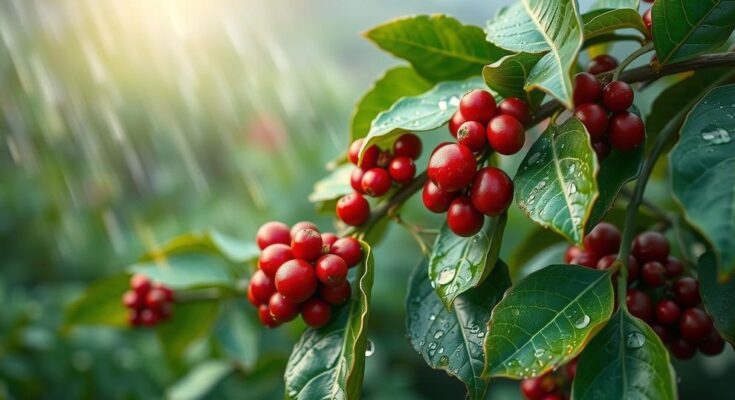Coffee prices surged today as arabica reached a 1.5-week high, driven by insufficient rainfall in Brazil that may reduce crop yields. Contributing factors include decreasing inventories and a higher percentage of Brazil’s current coffee harvest already sold compared to prior years. Concerns surrounding supply continue to exert pressure on prices despite potential increases in global exports.
Coffee prices experienced an increase today, building upon Monday’s gains, with arabica reaching a 1.5-week high and robusta a 1-week high. The primary driver behind this price rise is insufficient rainfall in Brazil, which could adversely affect crop yields. Somar Meteorologia indicated that the key arabica-growing region of Minas Gerais received only 11.4 mm of rain by February 22, merely 24% of the historical average, as Monday’s report was postponed due to the Brazilian Carnival holiday.
The continuing decline of coffee inventories has also contributed to the price support, with ICE robusta inventories dropping to a two-month low of 4,247 lots as of last Friday. Furthermore, arabica inventories have similarly decreased to a 9.25-month low on February 18, totaling 758,514 bags, although recent reports indicate a slight recovery to 809,128 bags.
Positive market sentiment is bolstered by a higher percentage of Brazil’s coffee harvest already being sold compared to previous years. As of February 11, Safras & Mercado reported that producers sold 88% of the 2024/25 coffee harvest, exceeding last year’s figures of 79% and the five-year average of 82%. In contrast, the sale of the 2025/26 crop remains sluggish at just 13%, far behind the four-year average of 22%.
Concerns surrounding coffee supply continue to bolster prices, as evidenced by Cecafe reporting a 1.6% year-over-year decline in Brazil’s January green coffee exports, totaling 3.98 million bags. Furthermore, Conab forecasts indicate a 4.4% decrease in Brazil’s 2025/26 coffee crop to 51.81 million bags, alongside a minor reduction in the 2024 estimate from 54.8 million bags to 54.2 million bags.
Ongoing dry weather attributed to El Niño conditions is anticipated to cause long-term damage to coffee crops in South and Central America. Since last April, rainfall in Brazil has consistently fallen below average, negatively impacting coffee trees during crucial growth periods, ultimately reducing the prospects for the 2025/26 arabica crop. Additionally, Colombia, recognized as the world’s second-largest arabica producer, is gradually recovering from last year’s drought caused by El Niño.
Robusta coffee prices are similarly supported by diminished production levels resulting from drought impacts in Vietnam, which saw a 20% drop in coffee output for the 2023/24 season. Projections for the upcoming 2024/25 marketing year indicate only a slight reduction in production to 27.9 million bags. However, Vietnam’s coffee exports have declined significantly, down 17.1% year-over-year, influencing market dynamics.
Contrasting these supply-influencing factors, the potential for increased global coffee exports dampens price expectations. Reports indicated a robust 28.8% year-over-year increase in Brazil’s 2024 coffee exports to 50.5 million bags, while Vietnam also reported rising exports in January. However, the ICO noted a 12.4% year-over-year drop in global coffee exports for December.
According to the USDA’s biannual report, coffee prices may face mixed influences as world coffee production is forecasted to increase by 4.0% year-over-year to 174.855 million bags in 2024/25. This includes slight increases in both arabica and robusta production. Despite these forecasts, the USDA has revised Brazil’s production estimate downward to 66.4 million bags for the 2024/25 cycle, indicating potential market tightening.
For the 2025/26 marketing year, Volcafe revised its estimate for Brazil’s arabica production downward to 34.4 million bags, reflecting the persistence of drought conditions. Projections suggest a coffee deficit of 8.5 million bags for that year may materialize, continuing a trend of deficits extending over five consecutive years.
In summary, coffee prices have risen significantly due to low rainfall conditions affecting Brazil’s crop yields, alongside shrinking inventories and accelerated sales of the current harvest. Increased concerns over long-term supply due to climate-related factors, coupled with ongoing drought impacts in Vietnam, further complicate the market outlook. Thus, while some factors suggest a bullish trend, the potential for increased exports may temper price expectations.
Original Source: www.tradingview.com




